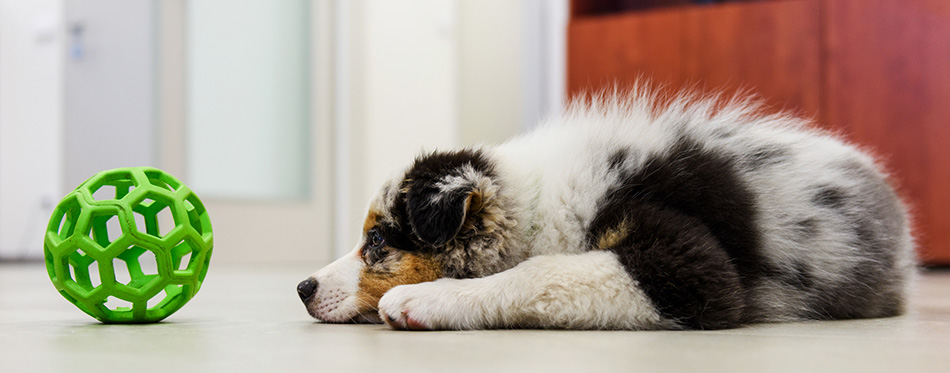Sadly, joint pain is not uncommon in dogs. Most cases of joint pain are caused by arthritis which is simply the medical term for ‘inflammation of the joints’.
A joint is a region of the body where two bones meet. In normal healthy joints, the surfaces of the two bones are covered with smooth cartilage and the area where they meet is lubricated with synovial (joint) fluid. This allows the joint to move freely with hardly any friction. When a joint is affected by arthritis, the cartilage breaks down and gets damaged so it is no longer smooth. There may also be some reduction in joint fluid. As a result, when the bones of the joint move, they scrape against each other which causes even more damage. This causes pain and a loss of mobility. Eventually, the increased friction triggers the formation of new bone and this makes the joint even less mobile. This is now termed a degenerative joint disease and gets worse over time.

Causes Of Joint Pain In Dogs
There are three types of arthritis in dogs.
- Osteoarthritis in dogs
Osteoarthritis is sometimes called Degenerative Arthritis or even Degenerative Joint Disease. Osteoarthritis can happen to any dog but it is more common in senior animals. Over time, some wear and tear of the joints is inevitable. Active and working dogs may be more vulnerable because their joints have had to work harder. Also, obese dogs are more at risk because the extra weight puts a huge strain on the joints. Damage caused by injuries to the bones or ligaments of a joint can also trigger osteoarthritis.
Sometimes, the condition can develop in younger dogs. This is often associated with a congenital (inherited) problem with the way that the joint is structured. The abnormality can lead to an increased strain on the joint and this, in turn, leads to early onset arthritis. A typical example is the poor conformation that some breeds have in their hip joint and this is called hip dysplasia. Larger breeds such as Labrador retrievers, Golden retrievers and German shepherds are more likely to have this condition. Osteoarthritis is often treated with medication or surgery and nutritional supplements may help too.
- Septic arthritis in dogs
Septic Arthritis is basically a bacterial or fungal infection of the joint fluid. The bacteria or fungus has somehow gained access to the joint and this is often following a severe fracture of the bone or after surgery.
It can be cured but it is challenging. Once the cause of the infection has been established, your dog will need antibiotics or anti-fungal medication and it may take some time to resolve. Some dogs that get Septic Arthritis go on to develop Osteoarthritis in the joint because permanent damage has been caused by the infection. It is important that dogs with septic arthritis are treated right away.
- Immune-Mediated Polyarthritis in Dogs
This is caused by the dog’s own immune system attacking the joints. It is the dog version of Rheumatoid Arthritis which is a debilitating joint condition in humans. The body’s white blood cells produce antibodies which attack the joint and cause a lot of damage. The joint becomes sore and inflamed. There is also a loss of movement.
No one is completely sure what causes it. Some experts suggest a link to over-vaccination or to some types of medication. Others suggest it is a response to chronic illness or infections. Sometimes, there is no clear cause. It can affect all or any joint including the spine. Some joints may be affected more than others.
If your four-legged friend is suffering from joint pain, there is a lot that you can do to help. They need to be assessed by your vet and may then benefit from medication, nutritional supplements or even surgery. Find out more about dog joint supplements here.
The problem you have is trying to spot that they are in pain in the first place. Here’s a guide to help you.

7 Signs Of Joint Pain In Dogs
Obviously, your pooch cannot tell you that they are in pain or explain where and when it hurts. Therefore, you have to become an expert in interpreting what is going on from the way that they are behaving. You can tell a lot by observing your dog closely. Here are the 7 telltale signs of joint pain that you should look out for.
- Limping
This is the classic sign of a joint problem and is one that is easy to spot. You will notice that your dog is avoiding putting weight on one particular limb. Watch them carefully as they walk around so that you can pinpoint which limb is affected. The limp is often worse when they get up after lying down for a long time. You may notice that the limp gets better as your dog ‘warms up’ by moving around a bit. Don’t let this fool you. The issue still needs to be investigated.
- Loss of Agility
If a dog that used to leap into the trunk of a car now looks at you helplessly when you tell them to get in, it is a sure sign that something is wrong. A loss of mobility and agility is an indicative sign of arthritis. It is simply not easy for them to get around anymore so they avoid moving. Stairs can also be very challenging for a dog with arthritis. This lack of movement can lead to them gaining weight. They are not burning up calories in the way that they used to. Sadly, obesity makes the symptoms of arthritis worse as the extra weight puts a strain on the joint. It is a vicious circle and you need to step in to break it.
- Fatigue
There are lots of potential causes of fatigue in dogs including infection, diabetes and heart disease. These all need to be checked out by your vet. A dog with arthritis may spend more time resting or sleeping. They may not be as keen on going for walks as they used to be and they may prefer shorter walks as opposed to long hikes. Tell your vet if this happens and don’t just put it down to old age!
- Spinal Problems
Spinal arthritis is often a result of Immune-Mediated Polyarthritis. It is likely that other joints are affected as well. Your pooch will have a sore neck and back and they will show this by adopting a “hunch” in their back. You will probably notice this change in their posture. They may also be lame in one or both of their hind legs and can have great difficulty walking around. This needs to be investigated right away by your vet.
- Irritation and Depression
Being in constant pain is no joke. Your dog cannot tell you that they are in pain but their personality may change. This should alert you to the fact that something is wrong. Many dogs show that they are in pain by being either irritable or depressed. Dogs are usually very sociable and out-going creatures who are desperate to please their owners. A dog that is depressed or irritable may become snappy or withdrawn. They may hide away and refuse to interact with you. They may have trouble sleeping and they may go off their food. Talk to your vet straight away if this happens.
- Muscle Wasting
When a dog cannot use their muscles as they used to, those muscle groups get smaller. The medical term for this is muscle atrophy. The muscles waste away because they are not being used. It is a localized condition that happens in the muscles around the affected joint. So, if your dog is experiencing joint pain in their knee, you will notice the muscle wasting away in this region. The leg will appear thinner compared to the other. The condition is often reversible once that joint pain has been relieved.
Read here our review of Knee Braces for Dogs.
- Biting and Licking a Joint
When a dog is in pain from a particular part of their body, they will try to deal with the discomfort themselves. To your dog, the pain of arthritis may feel like they have a wound or a foreign body in the skin. They will try to make it better by chewing or biting the joint or by licking it excessively.
You may catch your dog doing this a lot and it can lead you to which joint is causing the discomfort. The incessant licking and biting can also cause localized inflammation of the skin so it may look swollen or red. There may also be patches of hair missing in the affected area.
Now that you know the 7 signs of joint pain you can be alert for these changes in your pooch. Most joint pain is manageable with the help of your vet so hopefully, your pooch will soon be feeling much better.

